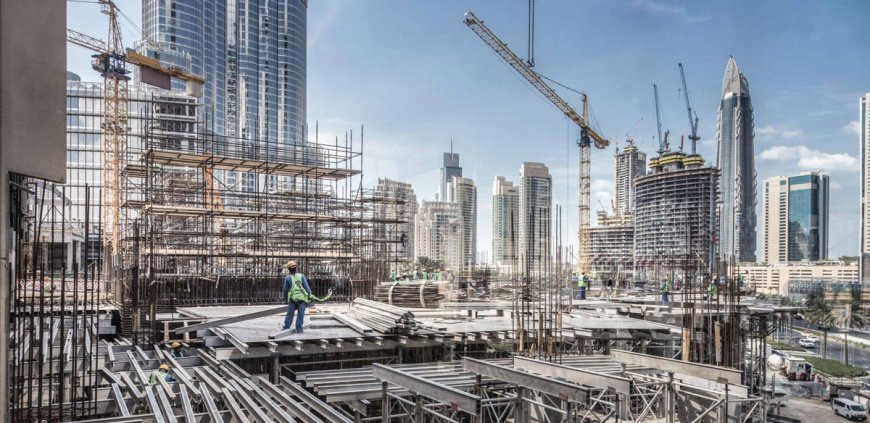India’s real estate sector has seen significant transformation over the last few years and the year 2024 has been phenomenal for the sector. As we enter another year of opportunities and challenges, Construction Times finds out how the sector will progress in the new year.
As the fastest growing economy in the world, India is transforming on various fronts in the recent times. Growing construction industry has been a key contributor to this transformation with a range of developments and modernization are happening in infrastructure and real estate sectors. Real estate sector in particular has seen tremendous uptick in the last couple of years with growing urbanization and modernization in buildings and urban ecosystem. Residential real estate market has thrived with more and more cities are being developed and modernization is gaining pace, apart from the government push for the affordable housing. Growth in infrastructure developments and industrialization has also pushed the growth of real estate market, especially in the commercial real estate segment.
Looking back to 2024
According to a year-end note from CBRE, in 2024, India's real estate sector emerged as a formidable force, surging ahead on the wings of robust demand, diversified growth, and investor optimism. “This year is set to be a landmark year, marked by record-breaking office leases, a decade-high in residential sales and launches, and soaring consumer confidence in the residential segment. Significant foreign investments and expansions by multinational corporations are further fuelling the sector's growth trajectory,” the report says.
 Residential segment thriving: India's housing market remains resilient, underpinned by strong fundamentals and a consistent demand for residential properties. “In the first nine months of 2024, residential sales surpassed 225,000 units, bolstered by the launch of 215,000 new projects. This dynamic market saw Mumbai and Pune accounting for nearly 50% of the overall residential supply and demand activity, with other prominent markets such as Hyderabad, Bengaluru, and Delhi-NCR contributing significantly to the national numbers,” says Anshuman Magazine, Chairman & CEO - India, South-East Asia, Middle East & Africa, CBRE.
Residential segment thriving: India's housing market remains resilient, underpinned by strong fundamentals and a consistent demand for residential properties. “In the first nine months of 2024, residential sales surpassed 225,000 units, bolstered by the launch of 215,000 new projects. This dynamic market saw Mumbai and Pune accounting for nearly 50% of the overall residential supply and demand activity, with other prominent markets such as Hyderabad, Bengaluru, and Delhi-NCR contributing significantly to the national numbers,” says Anshuman Magazine, Chairman & CEO - India, South-East Asia, Middle East & Africa, CBRE.
In terms of demand, the mid-end segment continued to lead India's housing sales, contributing approximately 43% of the total residential demand during 9M 2024. This was followed by the high-end segment, which accounted for around 27% of the market. Notably, the premium and luxury housing segments experienced a remarkable rise in demand, with their collective share of the overall residential demand increasing from 6% in 2019 to 16% in the first nine months of 2024. This surge in demand for premium and luxury properties has prompted developers to launch a substantial number of new projects, making up about 19% of India’s total new residential launches during the period.
 According to Ravindra Pai, Managing Director, Century Real Estate, the luxury housing segment experienced significant growth, driven by a shift in buyer preferences. “In the first half of 2024, Century saw 45% of its sales come from this thriving luxury residential segment. This surge in demand has shaped our approach to luxury real estate, allowing us to adapt and expand our offerings,” he adds.
According to Ravindra Pai, Managing Director, Century Real Estate, the luxury housing segment experienced significant growth, driven by a shift in buyer preferences. “In the first half of 2024, Century saw 45% of its sales come from this thriving luxury residential segment. This surge in demand has shaped our approach to luxury real estate, allowing us to adapt and expand our offerings,” he adds.
 Highlighting on the trends in affordable segment, Kumar Satyaki, Joint Managing Director, Eden Realty Group, adds, “In 2024, the residential real estate market experienced robust growth, particularly in the affordable and mid-income segments, driven by government initiatives like PMAY, which spurred demand in Tier 2 and Tier 3 cities.”
Highlighting on the trends in affordable segment, Kumar Satyaki, Joint Managing Director, Eden Realty Group, adds, “In 2024, the residential real estate market experienced robust growth, particularly in the affordable and mid-income segments, driven by government initiatives like PMAY, which spurred demand in Tier 2 and Tier 3 cities.”
Office real estate: According to CBRE, India's office real estate market has witnessed exceptional performance in 2024, with record-breaking leasing activity totalling 53.3 mn. sq. ft from January to September. During the same period, 36.2 mn. sq. ft of new office space was completed, with Bengaluru, Hyderabad, and Pune contributing 66% of the total supply. Global capability centres (GCCs) were a major driver, accounting for 38% of the leasing activity, particularly in Bengaluru (49%), Hyderabad, Pune, and Chennai.
The year-end report of Vestian says that the office market faced initial challenges in the first quarter of 2024, with moderate absorption and restricted new completions due to global economic uncertainty and ongoing geopolitical tensions between Russia and Ukraine. However, the market rebounded significantly in Q2 2024, registering a quarterly increase of 27% in absorption and 15% in new completions. The growth momentum continued in Q3 2024 as well with an increase of 9% in absorption and 3% in new completions.
Logistics and warehousing: According to Vestian, the warehousing & logistics sector witnessed robust absorption of 16.6 mn sq ft in the first half of 2024, registering an increase of 8% over H1 2023 and 26% as compared to H1 2022. However, absorption declined by 26% when compared to H2 2023.
The sector is expected to surpass absorption levels of 2023 bolstered by robust institutional investments, Production-Linked Incentive (PLI) schemes, development of freight corridors, and a booming e-commerce industry.
Micro-markets like Bhiwandi and Navi Mumbai in Mumbai, along with Pune’s peripheral areas saw heightened demand for warehouses during H1 2024.
According to CBRE, India's industrial and logistics (I&L) leasing activity has demonstrated remarkable growth, reaching 27.5 mn sq. ft in the first nine months of 2024. The regions of Delhi-NCR, Kolkata, and Bengaluru collectively accounted for approximately 61% of the total space take-up. Third-party logistics (3PL) players dominated the market, securing a substantial share of around 39%, as businesses increasingly outsourced their storage and delivery operations to reduce lead times and optimize operational costs. Engineering & manufacturing (E&M) and retail sectors also played significant roles, contributing to an additional 30% of total warehousing space absorption between January and September 2024.
Investment inflow: CBRE finds out that in 2024, India’s real estate market experienced a significant surge in equity capital inflows, reaching a new high of USD 8.9 billion in the first nine months of the year, reflecting a 46% year-on-year increase. This robust growth was primarily driven by a resurgence in capital deployment during the July-September quarter. Approximately 200 investment deals were recorded during this period, an increase from 151 deals in the same period in 2023. The average deal size rose from around USD 36 million in 2023 to approximately USD 45 million in 2024, with mid-sized deals representing 56% of the total investment inflows.
The major gateway cities of Delhi-NCR, Mumbai, and Bengaluru accounted for over 63% of the total investment inflows, with Delhi-NCR leading the pack with a 26% share, amounting to roughly USD 2.3 billion. Meanwhile, equity capital inflows into tier-II and III cities reached around USD 600 million, with Ludhiana, Mohali, Tuticorin, Hubli, Coimbatore, and Indore collectively contributing to approximately 76% of these inflows.
According to Vestian findings, foreign investors adopted a cautious approach amid geopolitical challenges, resulting in significantly low investments of USD 0.6 billion in Q1 2024. However, investments saw a surge to USD 3.1 billion in Q2 2024, followed by a sudden dip to USD 0.96 billion in Q3 2024. Despite this volatility, investments in the first nine months of 2024 have already surpassed the total investments for 2023. Moreover, 9M 2024 received investments worth USD 4.61 billion, an increase of 31% compared to the same period a year earlier.
 “The year 2024 was full of challenges and uncertainties, yet the Indian real estate sector remained resilient. While the government’s emphasis on infrastructure development and affordable housing fueled domestic demand, India’s robust economic performance lured foreign investors. All in all, the Indian real estate sector has been driven by an increase in domestic consumption and easy financing options,” says Shrinivas Rao, FRICS, CEO, Vestian.
“The year 2024 was full of challenges and uncertainties, yet the Indian real estate sector remained resilient. While the government’s emphasis on infrastructure development and affordable housing fueled domestic demand, India’s robust economic performance lured foreign investors. All in all, the Indian real estate sector has been driven by an increase in domestic consumption and easy financing options,” says Shrinivas Rao, FRICS, CEO, Vestian.
What to look for in 2025
As we enter the new year 2025, the Indian real estate sector finds itself at the crossroads of transformation. While the real estate market is looking ahead for many opportunities in the year ahead, certain challenges pose as hurdles in these growth opportunities. Sahil Saharia, CEO, Shristi Infrastructure Development Corporation Ltd, highlights, “As we enter the new year, the rising interest rates remain a significant concern, as they could dampen demand. Global economic uncertainty, driven by geopolitical tensions and the risk of a potential economic slowdown, poses additional risks to investor sentiment and investment flow.”
 According to Vaibhav Kathotia, Chief Operating Officer, Real Estate, Crest, the sector has shown remarkable resilience amid global economic challenges, and emerging trends signal a dynamic and promising future. “Mixed-use developments, which integrate residential, commercial, and recreational spaces, continue to gain traction, especially in urban centers. These projects cater to the growing demand for convenience and community living, offering a blend of work, life, and leisure within a single location,” he adds.
According to Vaibhav Kathotia, Chief Operating Officer, Real Estate, Crest, the sector has shown remarkable resilience amid global economic challenges, and emerging trends signal a dynamic and promising future. “Mixed-use developments, which integrate residential, commercial, and recreational spaces, continue to gain traction, especially in urban centers. These projects cater to the growing demand for convenience and community living, offering a blend of work, life, and leisure within a single location,” he adds.
The government’s continued focus on affordable housing, urban infrastructure, and smart city initiatives is expected to drive the sector forward. “The real estate sector in 2025 is poised for sustained growth, driven by innovation, adaptability, and a strong emphasis on sustainability. Developers, investors, and other stakeholders must align their strategies with these emerging trends to unlock opportunities and navigate challenges,” Kathotia concludes on a cautiously optimistic note.

 Residential segment thriving: India's housing market remains resilient, underpinned by strong fundamentals and a consistent demand for residential properties. “In the first nine months of 2024, residential sales surpassed 225,000 units, bolstered by the launch of 215,000 new projects. This dynamic market saw Mumbai and Pune accounting for nearly 50% of the overall residential supply and demand activity, with other prominent markets such as Hyderabad, Bengaluru, and Delhi-NCR contributing significantly to the national numbers,” says Anshuman Magazine, Chairman & CEO - India, South-East Asia, Middle East & Africa, CBRE.
Residential segment thriving: India's housing market remains resilient, underpinned by strong fundamentals and a consistent demand for residential properties. “In the first nine months of 2024, residential sales surpassed 225,000 units, bolstered by the launch of 215,000 new projects. This dynamic market saw Mumbai and Pune accounting for nearly 50% of the overall residential supply and demand activity, with other prominent markets such as Hyderabad, Bengaluru, and Delhi-NCR contributing significantly to the national numbers,” says Anshuman Magazine, Chairman & CEO - India, South-East Asia, Middle East & Africa, CBRE.
 According to Ravindra Pai, Managing Director, Century Real Estate, the luxury housing segment experienced significant growth, driven by a shift in buyer preferences. “In the first half of 2024, Century saw 45% of its sales come from this thriving luxury residential segment. This surge in demand has shaped our approach to luxury real estate, allowing us to adapt and expand our offerings,” he adds.
According to Ravindra Pai, Managing Director, Century Real Estate, the luxury housing segment experienced significant growth, driven by a shift in buyer preferences. “In the first half of 2024, Century saw 45% of its sales come from this thriving luxury residential segment. This surge in demand has shaped our approach to luxury real estate, allowing us to adapt and expand our offerings,” he adds.
 Highlighting on the trends in affordable segment, Kumar Satyaki, Joint Managing Director, Eden Realty Group, adds, “In 2024, the residential real estate market experienced robust growth, particularly in the affordable and mid-income segments, driven by government initiatives like PMAY, which spurred demand in Tier 2 and Tier 3 cities.”
Highlighting on the trends in affordable segment, Kumar Satyaki, Joint Managing Director, Eden Realty Group, adds, “In 2024, the residential real estate market experienced robust growth, particularly in the affordable and mid-income segments, driven by government initiatives like PMAY, which spurred demand in Tier 2 and Tier 3 cities.”
 “The year 2024 was full of challenges and uncertainties, yet the Indian real estate sector remained resilient. While the government’s emphasis on infrastructure development and affordable housing fueled domestic demand, India’s robust economic performance lured foreign investors. All in all, the Indian real estate sector has been driven by an increase in domestic consumption and easy financing options,” says Shrinivas Rao, FRICS, CEO, Vestian.
“The year 2024 was full of challenges and uncertainties, yet the Indian real estate sector remained resilient. While the government’s emphasis on infrastructure development and affordable housing fueled domestic demand, India’s robust economic performance lured foreign investors. All in all, the Indian real estate sector has been driven by an increase in domestic consumption and easy financing options,” says Shrinivas Rao, FRICS, CEO, Vestian. According to Vaibhav Kathotia, Chief Operating Officer, Real Estate, Crest, the sector has shown remarkable resilience amid global economic challenges, and emerging trends signal a dynamic and promising future. “Mixed-use developments, which integrate residential, commercial, and recreational spaces, continue to gain traction, especially in urban centers. These projects cater to the growing demand for convenience and community living, offering a blend of work, life, and leisure within a single location,” he adds.
According to Vaibhav Kathotia, Chief Operating Officer, Real Estate, Crest, the sector has shown remarkable resilience amid global economic challenges, and emerging trends signal a dynamic and promising future. “Mixed-use developments, which integrate residential, commercial, and recreational spaces, continue to gain traction, especially in urban centers. These projects cater to the growing demand for convenience and community living, offering a blend of work, life, and leisure within a single location,” he adds.






